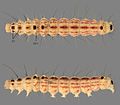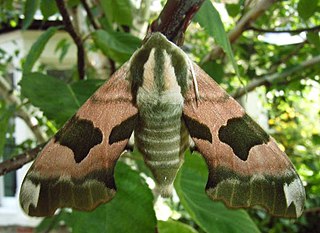
Mimas tiliae, the lime hawk-moth, is a moth of the family Sphingidae. It is found throughout the Palearctic region and the Near East, and has also been identified in Canada's east and western provinces and in northern Spain (Europe). The species was first described by Carl Linnaeus in his 1758 10th edition of Systema Naturae.

Laothoe populi, the poplar hawk-moth, is a moth of the family Sphingidae. The species was first described by Carl Linnaeus in his 1758 10th edition of Systema Naturae. It is found throughout the Palearctic region and the Near East and is one of the most common members of the family in the region. It is distinctive due to its habit of resting with its hindwings held further forward than the forewings.

Apatura iris, the purple emperor, is a Palearctic butterfly of the family Nymphalidae.
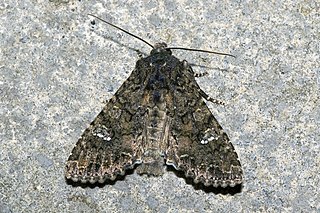
The cabbage moth is primarily known as a pest that is responsible for severe crop damage of a wide variety of plant species. The common name, cabbage moth, is a misnomer as the species feeds on many fruits, vegetables, and crops in the genus Brassica. Other notable host plants include tobacco, sunflower, and tomato, making this pest species particularly economically damaging.

Actias selene, the Indian moon moth or Indian luna moth, is a species of saturniid moth from Asia. It was first described by Jacob Hübner in 1807. This species is popular among amateur entomologists and is often reared from eggs or cocoons that are available from commercial sources. They fly mainly at night.

Daphnis nerii, the oleander hawk-moth or army green moth, is a moth of the family Sphingidae. It was described by Carl Linnaeus in his 1758 10th edition of Systema Naturae.

Apatura ilia, the lesser purple emperor, is a species of butterfly native to most of Europe and east across the Palearctic. It is named for its similarity to the purple emperor butterfly.

Geitoneura klugii, the common xenica or Klug's xenica, is a species of butterfly belonging to the family Nymphalidae. It is a southern Australian butterfly that is easily camouflaged because of its resemblance to the ground where it is usually found fluttering. It has a wingspan of about 38 millimetres (1.5 in). The upper and lower side of the forewing is black with brownish-black markings and contains a black spot with a white centre. The orange hindwing is set off by a black border and a black-rimmed eyespot. The underside of the hindwing ranges from grey to brown and consists of darker markings.
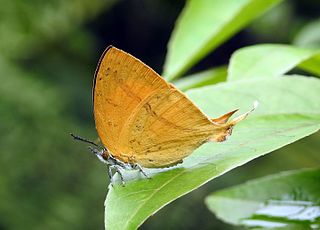
Loxura atymnus, the yamfly, is a species of lycaenid or blue butterfly found in Asia.
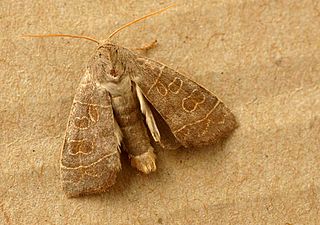
Ipimorpha subtusa, the olive, is a moth of the family Noctuidae. It is found in the Palearctic realm.

Trapezites iacchoides, commonly known as the silver studded ochre or iacchoides skipper, is a species of butterfly in the family Hesperiidae. It is endemic to Australia, where it occurs in New South Wales, Queensland and Victoria. It inhabits cool, temperate, open eucalypt forests.
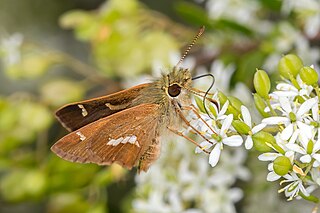
Dispar compacta, commonly known as the dispar skipper, barred skipper, or barred grass-skipper, is a species of butterfly in the family Hesperiidae. It was described by Arthur Gardiner Butler in 1882 as Telesto compacta and is endemic to eastern Australia.

Stigmella fulva is a moth of the family Nepticulidae. It is endemic to New Zealand and has been observed in the North Island around Mount Taranaki, in the South Island and at Stewart Island. The species' eggs are laid singly but a considerable number may be deposited on the upper surface of one leaf. The incubation period can last from a week to a month depending on climatic conditions. The larvae mine the leaves of their host plants which are all in the genus Olearia. Larvae have been recorded in all months except January, February and June. The cocoon is brown and spun amongst the leaf litter under its host plant. The pupal period has been shown to range from 21 days to 79 days, again depending on climatic conditions. Adults have been observed on the wing January until March and August to December. They are active in the sun about their larval food plant.

Sevenia boisduvali, the Boisduval's tree nymph, is a butterfly in the family Nymphalidae. There are four subspecies; all native to Africa.

Dixeia pigea, the ant-heap small white or ant-heap white, is a butterfly in the family Pieridae that is native to Africa.
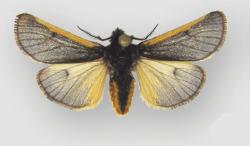
Andesobia jelskii is a species of moth of the subfamily Arctiinae first described by Charles Oberthür in 1881. It is found in the Department of Junín in Peru.
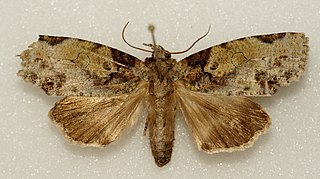
Gadirtha inexacta is a moth of the family Nolidae first described by Francis Walker in 1858. It is found in northern India and Myanmar, as well as on Borneo. It has also been recorded from Queensland and New South Wales in Australia.

Papilio rumiko is a species of swallowtail butterfly. It is found from the south-western United States, through Mexico, El Salvador, Honduras, Costa Rica to Panama. The northernmost record is north-eastern Colorado.

Ichneutica epiastra is a moth of the family Noctuidae. It is endemic to New Zealand and is found throughout the North, South and Stewart Islands. This species prefers open habitats such as wetlands, dunes and forest clearings. Eggs are laid in the summer or autumn and larvae feed during winter and spring. The larval host species are found within the genus Austroderia. The adult moths are on the wing between October and February. Adult I. epiastra can possibly be confused with the similar species I. arotis and I. haedifrontella however there are differences in appearance that enables I. epiastra to be distinguished from these two species. In particular I. epiastra has long sharp-tipped ‘horns' on its head that are diagnostic. The adults of this species appear reluctant to be attracted to light although they do come more frequently to the brighter mercury vapour traps.

Proteodes carnifex is a species of moth in the family Depressariidae. It is endemic to New Zealand. Both the larvae and the adults of this species are variable in appearance. However the adults are normally easily identified as the outline is characteristic and the size is consistent. In appearance, adult moths mimic the leaves of their larval host plants. This species has been found near Wellington in the North Island, the tableland of Mount Arthur, in the Canterbury region, Arthur's Pass and at Lake Wakatipu in the South Island. The larval hosts of this species are southern beech trees, particularly black beech and mountain beech but larvae have also been found on Nothofagus fusca, Nothofagus truncata and Nothofagus menziesii. The female moth deposits her eggs individually on the underside of native beech tree leaves. Once hatched the larvae feed on those leaves through winter and spring and then pupate in January. The adult moth emerges from the pupa after fourteen days and is on the wing from January until April. They are day flying moths and are not attracted to light. Various insects parasitise the larvae of this moth including several species of wasp as well as flies including the endemic fly, Pales funesta.


